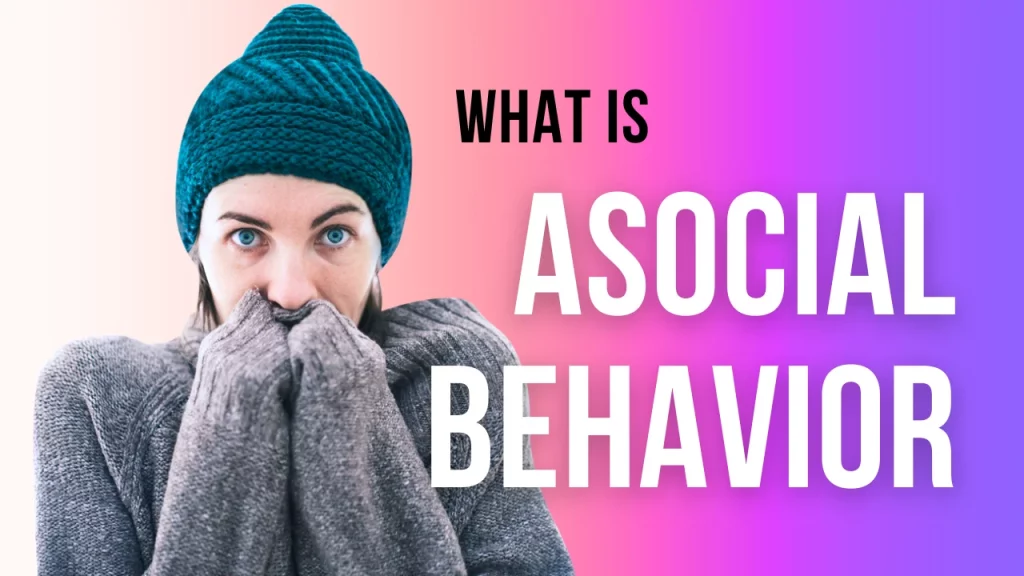What’s the Real Difference Between Asocial and Antisocial?
Ever heard someone describe a quiet person as “antisocial” and wondered if that’s the right term? You’re not alone. The difference between asocial and antisocial behavior is one of the most misunderstood aspects of psychology. But these terms are far from being identical twins. They’re more like distant cousins, each with their own unique traits and tendencies.
📚 Why This Matters
Understanding the key differences between asocial and antisocial behavior is not just for psychology buffs. It’s for teachers, parents, and anyone who interacts with other humans—which is basically all of us! This guide aims to set the record straight, pulling insights from expert psychologists and the latest research.
🤓 What You’ll Learn
By the end of this article, you’ll be a mini-expert on the topic! Here’s what we’ll cover:
- Asocial vs Antisocial Behavior: Definitions and characteristics
- Real-life Examples: From the classroom to the workplace
- Treatment Options: When and where to seek help
📝 Note: We’ve made sure to use easy-to-understand language and keep things jargon-free. So even if you’re new to psychology, you’ll find this guide accessible.
📘 Understanding Asocial Behavior
🤔 What is Asocial Behavior?

Asocial behavior is often misunderstood. Contrary to popular belief, being asocial doesn’t mean you’re antisocial. Asocial individuals generally prefer solitude over social interaction. They may have difficulty holding conversations, often withdraw from society, and usually miss social cues. These asocial traits stem from a lack of motivation to socialize rather than a disdain for other people.
📊 Statistics: According to a study published in the Journal of Abnormal Psychology, approximately 15-25% of people display asocial behavior at some point in their lives.
📚 Common Misconceptions About Asocial Behavior
- It’s Not Introversion: While asocial people may be introverted, not all introverts are asocial.
- Not Always a Sign of a Mental Disorder: Although asocial behavior can be a symptom of conditions like social anxiety disorder, schizophrenia, or chronic depression, autism spectrum disorder, or even chronic depression, although it’s usually more of a personality trait .
🌟 Real-life Examples of Asocial Behavior
- At Work: An asocial individual might not attend after-work social events, preferring solitary activities like reading or hiking.
- In Relationships: They might prefer spending one-on-one time with their partner over socializing in larger groups.
🩺 Causes and Treatment Options for Asocial Behavior
Causes:
- Social Anxiety
- Introversion
- Low Self-Esteem
- Autism Spectrum Disorder
Treatment:
- Cognitive Behavioral Therapy (CBT)
- Social Skills Training
- Medication for underlying conditions like social anxiety
📗 Understanding Antisocial Behavior
😠 What is Antisocial Behavior?

Antisocial behavior is characterized by a blatant disregard for social norms and the rights of others. Unlike asocial individuals, who simply prefer to avoid social interaction, antisocial individuals often engage in deceitful, manipulative, or even violent behavior.
📊 Statistics: According to the Diagnostic and Statistical Manual of Mental Disorders, Fifth Edition (DSM-5), ASPD has a lifetime prevalence of 1-4%.
📚 Common Misconceptions About Antisocial Behavior
- Not Synonymous with Criminal Behavior: While many criminals exhibit antisocial traits, not all antisocial individuals are criminals.
- More Than Just Hostility: Antisocial behavior can manifest as impulsivity, lack of empathy, and even high-risk activities.
🌟 Real-life Examples of Antisocial Behavior
- At Work: An antisocial person might manipulate coworkers to get ahead, showing no remorse for their actions.
- In Relationships: Antisocial individuals may use relationships solely to achieve their own goals, often at the expense of their partner’s emotional well-being.
🩺 Causes and Treatment Options for Antisocial Behavior
Causes:
- Antisocial Personality Disorder (ASPD)
- Childhood Trauma
- Genetic Factors
Treatment:
- Psychotherapy
- Medication for associated conditions like depression
- Anger Management Courses
Here is a table of prevalence rates of asocial and antisocial behavior in various demographics:
| Demographic | Prevalence rate of asocial behavior | Prevalence rate of antisocial behavior |
|---|---|---|
| Males | 20-30% | 10-20% |
| Females | 10-20% | 5-10% |
| Adolescents | 15-25% | 5-15% |
| Young adults | 10-20% | 5-10% |
| Adults | 5-10% | 2-5% |
| Low-income groups | 15-25% | 5-15% |
| High-income groups | 10-20% | 5-10% |
| Urban areas | 15-25% | 5-15% |
| Rural areas | 10-20% | 5-10% |
According to the World Health Organization (WHO), approximately 1 in every 8 people in the world live with a mental disorder, which can include asocial and antisocial behavior 1
📕 Comparing Asocial and Antisocial Behavior

🤷♀️ Key Differences
Understanding the difference between asocial and antisocial behavior is crucial for both personal and societal well-being. While the terms are often used interchangeably, they represent distinct behavioral patterns and motivations. Here, we’ll break down the key differences based on various dimensions: social interactions, emotional connection, motivation, and impact on society.
Social Interactions
Asocial Behavior: Avoidance or Disinterest in Social Interactions
Asocial individuals often steer clear of social activities, not because they aim to harm others but because they simply prefer their own company. This can sometimes be linked to social anxiety disorder or introversion.
📌 Note: If you notice someone avoiding social situations, it’s not necessarily a sign of a problem; they may simply prefer a quieter lifestyle.
Antisocial Behavior: Actively Engaging in Harmful or Disruptive Social Interactions
Unlike asocial people, those with antisocial tendencies engage in behaviors that are disruptive, harmful, or even criminal. This can range from deception and manipulation to outright violence.
🚨 Tip: If someone exhibits disruptive behavior that harms others, it’s crucial to consult a mental health professional for an accurate diagnosis and appropriate treatment.
Emotional Connection
Asocial Behavior: Lack of Emotional Attachment or Interest in Forming Relationships
People who are asocial might have limited emotional bonds and may not be particularly interested in forming new relationships. This could be a personal preference or rooted in social anxiety or other mental health conditions.
📌 Note: A lack of emotional connection isn’t necessarily problematic unless it leads to distress or functional impairment.
Antisocial Behavior: Manipulative or Exploitative Behavior Towards Others
Individuals with antisocial behavior often use emotional manipulation as a tool to exploit others. They may feign emotional connection to achieve personal goals, such as power or financial gain.
🚨 Tip: Emotional manipulation is a red flag and may indicate a deeper personality disorder requiring professional evaluation.
Motivation
Asocial Behavior: Personal Preference for Solitude or Individual Activities
The motivation behind asocial behavior is usually a personal preference for solitude. They find peace and comfort in being alone and may choose hobbies that don’t require social interaction.
📌 Note: Enjoying solitary activities isn’t inherently bad; it’s simply a different lifestyle choice.
Antisocial Behavior: Desire for Power, Control, or Personal Gain at the Expense of Others
Antisocial behavior is driven by a quest for power, control, or personal gain, often at the expense of others. This self-centered motivation can lead to harmful or even criminal activities.
🚨 Tip: Such motivations should be considered serious warning signs, and immediate professional help should be sought.

Impact on Society
Asocial Behavior: Generally Harmless and Does Not Pose a Threat to Others
Asocial behavior is typically harmless to society. These individuals prefer to keep to themselves and rarely disrupt social norms or harmony.
📌 Note: Being asocial is generally a personal choice and should be respected as long as it doesn’t lead to severe social impairment.
Antisocial Behavior: Can Lead to Criminal Activities, Violence, or Disruption of Social Harmony
In contrast, antisocial behavior can be significantly harmful to society. Individuals with this behavioral pattern may engage in activities ranging from petty crimes to serious offenses, causing societal disruptions.
🚨 Tip: Any antisocial behavior that poses a threat to society should be addressed immediately, and appropriate legal and medical measures should be taken.
🤷♂️ Similarities
Both asocial and antisocial behaviors involve a limited scope of social interaction. However, the difference lies in their motivations and the impact of their behavior on others.
🎓 Psychological Perspectives
From a psychological standpoint, asociality is often linked with conditions like social anxiety disorder and autism spectrum disorder. Antisocial behavior is strongly associated with Antisocial Personality Disorder (ASPD) and often requires more intensive treatment.
The National Institute of Mental Health (NIMH) reports that the prevalence of any personality disorder in adults aged 18 and older is 9.1%, while the prevalence of borderline personality disorder is 1.4% 2.
📝 Tip: Understanding the differences and similarities between asocial and antisocial behavior can be crucial in settings like schools, workplaces, and in diagnosing and treating mental health conditions.
📔 The Role of Social Anxiety and Antisocial Personality Disorder
🧠 Social Anxiety’s Impact on Asocial Behavior
Social anxiety disorder is one of the leading causes that may drive asocial behavior. People with social anxiety may find comfort in their lack of social interaction, viewing it as a safe zone from potentially judgmental or uncomfortable social situations.
🗂 Diagnostic Criteria According to DSM-5: The Diagnostic and Statistical Manual of Mental Disorders (DSM-5) outlines specific criteria for diagnosing social anxiety disorder, which can often overlap with asocial tendencies.
| Diagnostic Criterion | Asocial Behavior (if applicable) | Antisocial Personality Disorder |
|---|---|---|
| Disregard for and violation of the rights of others | Yes | Yes |
| Failure to conform to social norms concerning lawful behaviors | Yes | Yes |
| Deceitfulness, repeated lying, use of aliases, or conning others for pleasure or personal profit | Yes | Yes |
| Impulsivity or failure to plan | Yes | Yes |
| Irritability and aggressiveness, often with physical fights or assaults | Yes | Yes |
| Reckless disregard for the safety of self or others | Yes | Yes |
| Consistent irresponsibility, failure to sustain consistent work behavior, or honor monetary obligations | Yes | Yes |
| Lack of remorse, being indifferent to or rationalizing having hurt, mistreated, or stolen from another person | Yes | Yes |
| Must be evident by age 15 | Yes | Yes |
| Must cause significant impairment in social, occupational, or academic functioning | No | Yes |
😈 Antisocial Personality Disorder (ASPD) Explained
Antisocial Personality Disorder (ASPD) is a condition often misunderstood to mean an aversion to social interaction. However, ASPD actually refers to a chronic condition characterized by manipulative, exploitative, and often criminal behavior, lacking regard for the well-being of others.
📊 Statistics: According to experts, individuals with ASPD are often involved in criminal activities and may struggle to maintain long-term relationships due to their lack of empathy and disregard for social norms.
🌎 The Impact of Culture and Environment
🎭 Cultural Norms and Their Influence
Different cultures have various norms and stigmas associated with asocial and antisocial behaviors. In some cultures, asocial behavior might be more accepted or even encouraged, viewed as a sign of deep introspection or focus.
🏡 Environmental Factors
External factors like upbringing, education, and social circle can also contribute to both asocial and antisocial tendencies. For example, a person raised in a neglectful environment may develop antisocial traits as a coping mechanism.
🌐 Global Perspective: Understanding how different cultures view asocial and antisocial behaviors can help in the global discussion about mental health awareness and treatment options.
🦄 Myths and Misconceptions
🚫 Debunking Common Myths
- Asocial Equals Antisocial: One of the most prevalent myths is that asocial and antisocial behavior are the same. However, they are distinct in both motivation and manifestation.
- Born That Way: Another myth is that people are born asocial or antisocial, disregarding the complex interplay of genetic and environmental factors.
💡 Clarifying Misunderstandings
- Not Always Negative: Being asocial is not inherently negative; some people prefer solitary activities for peace and personal growth.
- Treatment Avenues: Contrary to popular belief, antisocial behavior, especially when diagnosed as ASPD, can be managed through specialized psychological treatment.
📝 Note: Recognizing and debunking these myths is the first step in promoting a more nuanced understanding of asocial and antisocial behaviors and reducing societal stigmas.
💡 Treatment and Coping Strategies
🌱 Therapy Options for Asocial Behavior
Various therapeutic methods can help individuals manage asocial tendencies. Cognitive-behavioral therapy (CBT), for example, can help you understand the root causes of your preference for solitude or social anxiety disorder, and develop coping strategies.
Van Dongen, Josanne D. M.; Buck, Nicole M. L.; Barendregt, Marko; Van Beveren, Nico M.; De Beurs, Edwin; Van Marle, Hjalmar J. C. (2015). “Anti-social personality characteristics and psychotic symptoms: Two pathways associated with offending in schizophrenia”. Criminal Behaviour and Mental Health.
📚 Books and Articles: There’s a wealth of literature on managing asocial behavior. From clinical guides for treatment to self-help books, these resources can aid in understanding and managing asocial traits.
💊 Medications for Antisocial Personality Disorder
For those diagnosed with Antisocial Personality Disorder (ASPD), certain medications like mood stabilizers or antipsychotics can be recommended as part of a comprehensive treatment plan.
🔬 Latest Research: New research in pharmacology is exploring medications that could mitigate the symptoms of antisocial behavior, including impulsivity and lack of empathy.
| Treatment Option | Efficacy Rate | Asocial Behavior | Antisocial Personality Disorder |
|---|---|---|---|
| Psychotherapy | Moderate to high | Yes | Yes |
| Medication | Limited | Yes | Yes |
| Social skills training | Moderate | Yes | Yes |
| Anger management training | Moderate | Yes | Yes |
| Cognitive behavioral therapy (CBT) | Moderate to high | Yes | Yes |
| Dialectical behavior therapy (DBT) | Moderate to high | Yes | Yes |
| Family therapy | Moderate | Yes | Yes |
📋 Case Studies
📖 Real-Life Examples of Asocial Individuals
We’ll explore case studies that highlight the everyday lives of asocial individuals, how they manage social situations, and how treatment has helped them.
🚨 Real-Life Examples of Individuals with Antisocial Behavior
These case studies delve into the lives of individuals diagnosed with Antisocial Personality Disorder, looking at both their struggles and the treatments that have proved effective for them.
🔍 Expert Insights: Psychologists and behavioral experts weigh in on these cases, providing a well-rounded perspective on asocial and antisocial personalities.
🎯 Conclusion
We’ll summarize the key differences between asocial and antisocial behavior, the impact of social anxiety and Antisocial Personality Disorder, and the available treatment options.
As we conclude, we’ll share final thoughts on how understanding the difference between asocial and antisocial behavior can improve mental health awareness and treatment.
Reference
Mayo Clinic – Antisocial Personality Disorder
NHS – Antisocial Personality Disorder

